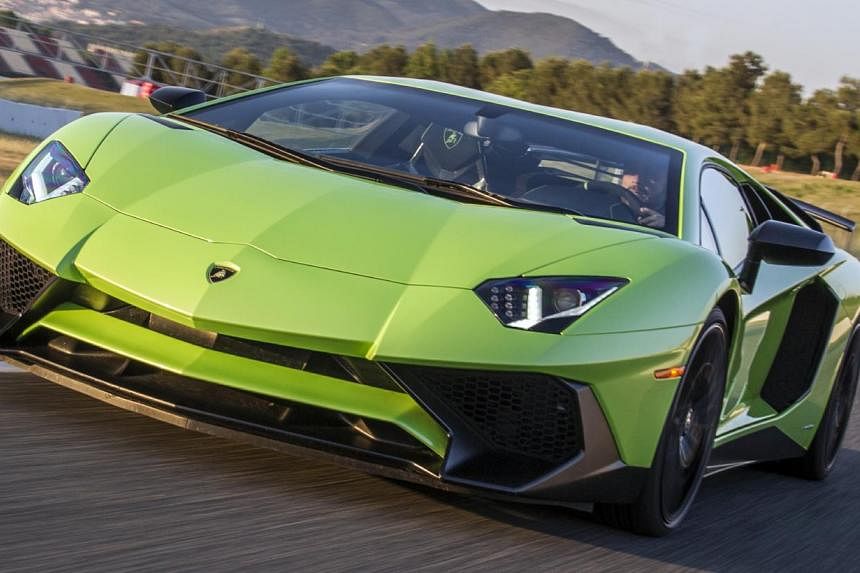Superveloce, or SV in short, is not a term heard very often. It was first applied to the Lamborghini Muira SV in 1971.
And it was not until 1995 that Lamborghini repeated it with the Diablo SV and, most recently, the Murcielago SV in 2009.
These models, especially the Muira SV, remain the most desirable and collectable Lamborghinis to date.
So, what then is a Superveloce? Well, it is a Lamborghini that has undergone a comprehensive weight-loss programme, detailed chassis enhancements and tweaking of its V12 engine.
And in the case of the latest Aventador SV, aerodynamic aids are part of the package.
Having been originally endowed with a full carbon-fibre monocoque chassis and body means there are slim pickings when it comes to lightening the Aventador. But Lamborghini has more tricks up its sleeves.
It has fabricated new doors, rocker and fender panels from what it calls SMC Superlight - a Boeing-developed aerospace composite using short strands of carbon-fibre in the sheet-moulding process to attain a sturdier, much lighter component.
Lamborghini had collaborated with Boeing to produce the carbon-fibre chassis of the Aventador.
The car's rear active spoiler has been replaced by an adjustable carbon-fibre wing that creates 218kg of downforce (up from the Aventador's 74kg). Along with a redesigned rear end, it contributes to engine cooling and weight saving.
One of the biggest weight savings comes from a new quad-pipe rear muffler, which enhances performance and gives the exhaust a distinctive straight- through sound.
All in all, Lamborghini managed to lighten the car by 50kg, reducing its weight to 1,525kg, despite having added beefier components such as MagnaRide suspension and a variable-ratio steering system.
Being an SV also means getting a perfunctory hike in horsepower. The Aventador's engine output goes from 700bhp to 750bhp and peaks at 8,400rpm instead of 8,250rpm.
This was done by optimising the engine's variable intake system and variable valve timing. Its new and lighter muffler system, which allows freer flowing exhaust, probably contributed as well.
Put that package together and the Aventador Superveloce becomes something really amazing, lapping the Nurburgring Nordschliefe circuit in just under seven minutes. Only one other series production car could match that feat: the uber-hybrid Porsche 918.
The Porsche 918 was limited to just 918 units, but the Aventador SV will be even rarer, being limited to 600 worldwide.
As we arrived to drive the car at the Catalunya F1 circuit, we were told that 500 had already been sold.
Being strapped into a beast with 750bhp, I can say I am glad it has the latest Haldex all-wheel-drive system, which is part active stability and part traction control. It can apportion as much as 60 per cent of torque to the front wheels and up to 90 per cent to the rear.
This works brilliantly with the car's MagnaRide suspension to deliver exceptional handling stability and handling flexibility.
As the test-drive was restricted to just track driving, we spent the entire session pushing the Aventador SV to the limit. There are very few cars with more than 700bhp that will allow a driver to use almost his entire performance envelope in just one morning. The car's chassis is so communicative that you can feel a slide beginning and initiate corrective action before it goes too far.
The engine is normally aspirated, allowing the throttle to be a very precise tool with which to control not only performance but also the car's handling.
Back off a few millimetres and the SV's nose tightens the line. Take off even more and the tail starts to slide. Apply more power and the nose runs wide. What is really amazing is this can be done confidently because the chassis is so balanced.
In Strada (street or normal) mode, the car's electronic stability system reins in the exuberance quite early into a slide. This can be annoying for spirited drivers.
Sport is a much better setting for track work. You can set the transmission to full auto or manual. The Sport Auto automatically downshifts into the appropriate gear as you slow down for each corner.
Corsa is the most unforgiving mode as it minimises electronic intervention and allows only manual shifting. But it is also the most satisfying mode when you get it right.
The Aventador SV is a rare find in an era of over-the-top hyper cars. It is a pure driving tool that relies on the good old combination of analogue chassis balance and naturally aspirated power, without resorting much to electronic trickery.
If you have about $1.9 million to spare, you might want to check it out when it arrives in September.
The writer is a regular contributor to Torque, a motoring monthly published by SPH Magazines.

